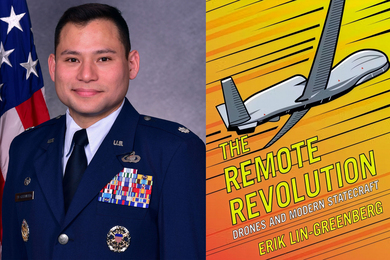It's not every day that high school students get the chance to visit MIT research labs and see concepts that they've learned about in classes come to life.
But that's exactly what happened Thursday, Feb. 14, as high-schoolers from around the country descended on MIT as part of the annual meeting of the American Junior Academy of Science (AJAS).
The AJAS meeting was held in conjunction with the annual meeting of the American Association for the Advancement of Science in Boston. Most of the 120 high school students in attendance won their way to Boston through science fair projects, which they presented at a poster session on Friday, Feb. 15.
On Thursday, the students got a taste of life and research at MIT, including lab tours, an afternoon at the MIT Museum and a talk by MIT Biology Professor Eric Lander.
Lander, director of the Broad Institute, offered students a glimpse of cutting-edge research in the field of genomics--something they will not learn about in their biology classes, he said.
"Textbooks always tell you about what we know, but what's interesting is what we don't know," said Lander. "Textbooks don't like to write about what we don't know, because it's hard to test you on it."
Lander told the students that biology is in the midst of a revolution that will transform the field, much as the development of the periodic table of elements transformed the study of chemistry in the 1800s.
The sequencing of the human genome, completed in 2003, is just the first step of that revolution, Lander said. Ongoing projects to map human genetic variation and determine the function of all human genes will open even more doors.
In about 10 or 15 years, scientists will have unprecedented resources and knowledge at their fingertips to help them study how human diseases arise and how to fight them, Lander said.
"The high school students of 2025 are not going to be able to understand what it was like to study biology in the benighted 20th century," he said.
After Lander's talk, students flocked to the front of the Broad Auditorium to ask questions or have their photo taken with him.
"His talk was incredible," said Zach Silver, a student from Pine Crest High School in Ft. Lauderdale, Fla.
Students also had the chance to tour about 20 MIT research labs. One group visited the Department of Aeronautics and Astronautics, where they heard from graduate students and postdoctoral researchers working on a variety of projects.
Christy Edwards, a graduate student in aero-astro, demonstrated the microsatellites that MIT students have been developing for several years.
Three of the volleyball-sized satellites are now onboard the International Space Station, where scientists will fine-tune the satellites' performance before they are sent into space on their own. "It's like driver's ed for satellites," Edwards explained.
In the Man-Vehicle Lab, the students got a peek at the lightweight, skintight spacesuit that Professor Dava Newman and her students are designing for future excursions in space.
Sachein Sharma, a sophomore at the Texas Academy of Science, said he enjoyed the tour of MIT's aero-astro projects. "It's very interesting and exciting," he said. "MIT is a great place for that kind of thing."
Sharma won his way to the AJAS conference by designing a new type of blade for a wind turbine. He envisions that someday wind turbines could be used in space, possibly on Mars' surface.
His research advisor, Cathy Bambanek, a chemistry teacher at the Texas Academy of Science, said she was impressed that much of MIT's research seems to be student driven.
"It's amazing," she said. "It seems like the students have a lot of input as far as what kind of projects they would like to work on."
The day at MIT was hosted by biology instructor Mandana Sassanfar and sponsored by the School of Science, School of Engineering, School of Architecture and Planning, Department of Biology and MIT Museum.
A version of this article appeared in MIT Tech Talk on February 27, 2008 (download PDF).






